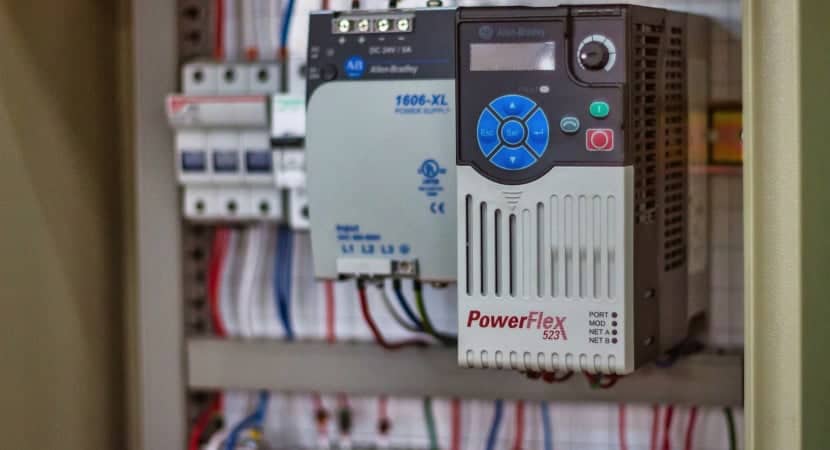PLC or Programmable Logic Controller is a computerized industrial controller that performs discrete or sequential logic in the factory or automation environment. Let’s look at the types of PLC modules used in rugged computers that operate under harsh conditions.
There are seven PLC module types:
- Rack or Chassis.
- Power supply (PS) Module.
- Central processing unit.
- Interface Module(IM).
- Signal Module (SM).
- Function Modules (FM).
- Communication Processor (CP).

By understanding the different types, you can choose the appropriate module for our automation environment to achieve our desired results.
Check this out: PLC Systems Uncovered: Advantages And Disadvantages Of PLC
Table of Contents
Types of PLC Modules
They are seven different types of PLC Modules. They are
- Rack or Chassis.
- Power supply (PS) Module.
- Central processing unit.
- Interface Module(IM).
- Signal Module (SM).
- Function Modules (FM).
- Communication Processor (CP).
Rack or Chassis
- The PLC Rack simultaneously runs the power signal and communication signal to all the other available modules and is the essential hardware in the system.
- In a control system, the size of the PLC depends on the needs of the control system we are using.
- The PLC racks provide all the electrical signals or connections and mechanical signals or connections to all the other modules.
- Even distribution of the power.
- It acts as an interface between the CPU and the other modules.
Below is the picture showing the PLC rack or chassis.

Power Supply (PS) Module
- This PS module checks whether the CPU and all other modules receive proper voltage supply throughout the PLU system.
- The system runs with the utmost of 24V DC voltage.
- This power supply module comes in different sizes based on the need and requirements of the PLC system.
- Even the rating changes according to the requirement and the need for the particular PLC module.
- The most general rating of this PS module is 5-20 amps for small PLC systems.
- 50 amps are the maximum rating of the PS module in complex and large PLC systems.
Below is the diagram for the PS module.

Central Processing Unit (CPU)
- The CPU is the most important and the brain of the system.
- The logical instructions written in the program are stored here.
- The CPU performs the arithmetic and logical operations.
- This module manages the computer memory, checking the status of the inputs and giving the output according to the user’s logical instructions.
- The data is stored in the memory and passed to the PLC.
Below is the diagram for this.

Interface Module (IM)
- This module expands the input and output memory when you don’t have enough space to store the data.
- This module helps you to create extra space to store these data when the main memory is full.
- After storing this data in the extra space rack, you must connect all these racks to the main rack to communicate with the PLC system and the CPU.
- This interface module will help you connect extra space racks to the main rack.
Below is the diagram for this module.

Signal Module (SM)
- As we know that there are various types of input and output data being stored or taken.
- This data can be digital or analog.
There are four types of signal modules available.
-
- Digital Input Module
- Digital Output Module
- Analog Input Module
- Analog Output Module
The combinations of these signal modules depend upon the user requirement, and the other factors.
Below is the diagram for this module.

Function Module (FM)
- Function module updates or changes the modularity of the PLC system.
- This kind of module finds its usage for unique controls such as.
-
- High-speed counter module.
- PID module.
- Weighing module.
-
Below is the diagram for the module.

Communication Processor (CP)
- As the name says, it is used for communication.
- This module primarily uses communication with different controllers and other devices.
- Examples are PLCs, SCADA, HMI, etc.
Below is the diagram of the interface.

FAQs
What Is A PLC?
PLC, i.e., Programmable Logic Controller, is an industrial computer based on custom programming with numerous inputs and outputs. It is used for monitoring and controlling industrial equipment.
Who Is The Father Of PLC?
An American mechanical engineer named Richard E. Morley is the father of PLC.
How Many Types Of Modules Are There In PLC?
There are seven different types of PLC modules. The modules are:- Signal module, Functional module, Rack, Interface Module, CPU, Power Supply Module, and Communication Processor.
What Is The Language Of PLC?
The most common programming language for Programmable Logic Controllers is Ladder Logic.
Conclusion
So these were the 7 types of PLC modules which are used in rugged computers that operate under harsh conditions.
See also: Machine Language: The Advantages And Disadvantages

